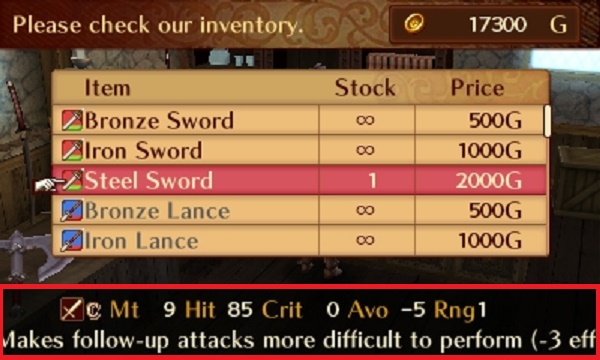Hello everyone, RR-sama here again! We’ve covered a lot of ground since we started, but we’re not quite done yet. Today we’ll be looking at one of the more important features of Fates that wasn’t in previous games in the series: Forging.
While some fans are already in the comments section writing about how forging was totally a thing in some previous Fire Emblem games, they’d only be half right. In Fates the weapons and forging system has been revamped to prevent overpowered weapons and straight upgrades. This means new weapon stats, new methods of attack, and more. As such, I’ve compiled it all into this simple guide. Enjoy!
Weapons
For all intents and purposes, the Japanese and European weapons parallel each other in some way. As such, any unit that can use the following can use the opposing faction’s equivalent:
- Sword = Katana
- Lance = Naginata
- Axe = Club
- Dagger = Shuriken
- Bow = Yumi
- Tome = Scroll
That said, each of the Japanese weapons tend to have stat modifiers when compared to their European counterparts. As a general rule of thumb, consider the following – unless otherwise noted by the weapons themselves:
- Katanas give +1 Speed, but have -1 Defense and Resistance
- Naginatas give +1 Defense and Resistance
- Clubs give +5 Hit Rate, but have -1 Mt (or damage)
- Shurikens give +2 speed and inflict various debuffs, but have -5 Hit Rate
- Yumi give +2 Resistance and +1 Mt, but have -10 Hit Rate
- Scrolls give various buffs, but have -5 Hit Rate

Unlike earlier games, each weapon has its own stats that make it better or worse depending on the situation. Some cause debuffs after use, some have higher or lower hit rates, and weapons that used to be straight upgrades now cause lower chances to follow up or so on. Be sure to keep all this in mind, and read the scrolling text at the bottom of the weapon store’s screen (marked in red) for more info on each individual weapon.
Forging
Forging has been completely revamped now that Fates removed weapon durability. To rebalance the game, players must now forge weapons to ensure that they stay relevant in the late game, as well as during online battles. This is done by visiting the forge and combining two like weapons.

When forging, you will come across this screen. In it, there are several valuable pieces of information (highlighted for your convenience). The blue box tells you whether or not you have the weapon required to forge an upgraded version, as well as who is carrying it (it will say Convoy if it is unequipped). In the green box, we have the number of ores it will take to forge said weapon. Lastly, the red box tells you how many of the required ores you have to craft the weapon you are hovering over.
Each weapon requires a different ore, and a different smithy to construct. Nohr weapons can only be forged in a Nohrian smithy, and likewise for Hoshido weapons. As for the ore list, it is as follows:
Nohrian Weapons
- Sword – Crystal
- Axe – Sapphire
- Lance – Ruby
- Tome – Topaz
- Bow – Emerald
- Dagger – Onyx
Hoshidan Weapons
- Katana – Pearl
- Club – Lapis
- Naginata – Coral
- Scroll – Amber
- Yumi – Jade
- Shuriken – Quartz

After selecting a weapon to upgrade, you will then choose which source you will be retrieving the second weapon required to forge the upgraded version. If there are alternate sources you can scroll left or right to choose another one. The number beside the source name (green) tells you how many that source is carrying. In this example, the convoy has 1 Takumi’s Shinai in stock. Once you have selected the source, the game will ask if you are certain about your choice. Hit the A button again to proceed.

Before the forging procedure, the game will confirm once more if this is what you want to do. Think of this screen (above) as your purchase receipt outlining what you are providing, and what you will be receiving in return. In this case, two Takumi’s Shinai are required to create a new one that will have an extra 2 damage. It is currently unknown what “Bon” is, but I assume it is the level of the weapon as two weapons must have the same Bon to combine.

The last screen in the forging lineup allows you to roleplay as Odin or Owain for a bit. That’s right, you get to name the new weapon! If you’d like to leave the name as is, simply click Back or OK. This will complete the transaction, and you will receive your new weapon!
In order to forge a new weapon with the upgraded version, you must first forge another upgraded weapon, then combine the two upgraded versions. For example, you would need 4 Iron Swords, and 4 crystals to make 1 Iron Sword +2. Keep this in mind, especially if you’re playing Conquest, as money and resources are scarce. Otherwise, if you have the resources, this can be done infinitely.
On a final note: try to only forge a new weapon when someone who uses that weapon type is in the forge. This reduces the number of ores required to forge higher level weapons.
Other Guides
This is all you need to know about weapons and forging! Be sure to check out my other Fire Emblem: Fates guides for more tips, tricks, and strategies, including:
Other Guides:
- Basic Strategy
- Advanced Strategy and Tips
- Support, Marriage, and Children
- Boons, Banes, and Talents
- Weapons and Smithing







Published: Feb 25, 2016 04:11 am